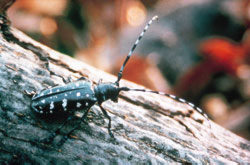The borough of Brooklyn has the unfortunate honor of being the
first place that the Asian Longhorned Beetle (Anoplophora glabripennis)
was spotted in the United States. It has since been found elsewhere in the New
York metropolitan area, including Manhattan, Queens, and Long Island, as well in
Chicago, Illinois. The beetle most likely arrived in Brooklyn from Asia on green
wooden "dunnage"—the packing crates and pallets used to import goods from
overseas. Beetles have been intercepted at ports in several states, but have
only escaped detection in New York and Illinois.
Why Is the Beetle Such a Pest?
It attacks many hardwood trees of major economic, environmental, and aesthetic
value, including all
Maples
Horsechestnuts
Birches
Willows
Elms
Poplars
Green ash, and
Black locusts
Adult beetles can be seen from around May to October. An adult
female beetle lays up to 70 eggs before dying, depositing each one in its own
site just beneath the bark. When the larvae hatch, they eat their way through
the tree, girdling stems and branches and causing structural damage. After the
larvae pupate, they tunnel out of the tree, leaving a hole (3/8 inch and larger)
when they exit. Eventually, this damage kills the tree.
The only way to destroy the beetle is to cut down, chip, and
incinerate the infested tree. Do not attempt to dispose of infested trees
yourself! Instead, contact the Department of Agriculture in your state.
What to Look For:
The beetles are 3/4 inch to 1-1/4 inches long.
Their black bodies have mottled white spots.
They have black and white striped antennae, 1 to 2 times
their body length.
Since the beetle spends most of its life inside the tree and
out of our sight, it is difficult to spot. Look instead for signs of its
presence:
Unusual die-back of branches and limbs
Oval or round shallow pits in the bark (these are egg sites)
Oozing sap
Piles of frass (looks like sawdust) around the base of the
tree or in the crooks of branches
Round holes (3/8 inch in diameter or larger) on the main
trunk or branches
Quarantine Zones:
While the Asian Longhorned Beetle can fly, adults tend to stay close to where
they hatch. Human transport of infested firewood or woody plant material is
thought to be the main vector for the spread of the beetle. For this reason, the
states of New York and Illinois have enacted quarantine zones. People handling
woody material greater than 1/2 inch in diameter may not move material across
the zone or discard wood. Landscaping companies handling host material are
required to undergo compliance training.
What Can YOU Do?
Examine trees in your neighborhood for signs of the Asian
Longhorned Beetle.
If you think you've found a beetle, collect a specimen in a
glass jar, put the jar in the freezer, and call one of the numbers listed below
to notify officials.
Don't plant host species! Planting species that the beetle
loves to eat only spreads the outbreak. Ask your local nursery to suggest
substitutes.
Don't move or discard wood across a quarantine zone
![]() Gardeners' Corner
Kids'
Garden
Sustainable Garden
Contact Us
Gardeners' Corner
Kids'
Garden
Sustainable Garden
Contact Us![]()


